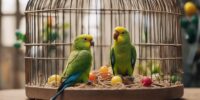What Are the Adaptations of Parrots Living in Urban Environments?
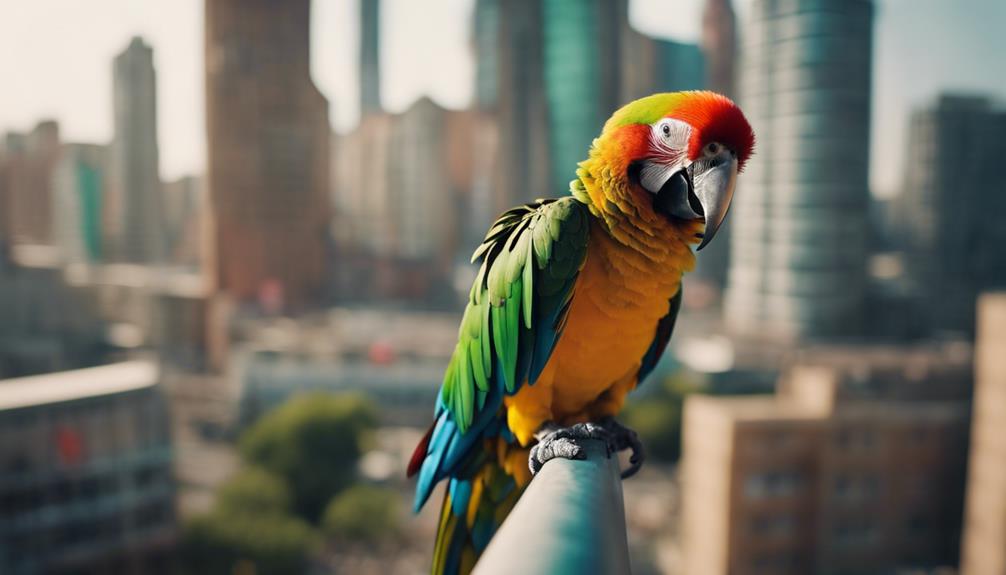
Adaptations of parrots in urban environments are fascinating to observe. These birds have shown a remarkable ability to nest in unconventional locations, such as building crevices and even street lamps. This nesting behavior allows them to take advantage of the limited green spaces in cities and avoid predators.
Furthermore, parrots have also adapted their diet to include a wider variety of foods found in urban areas, such as fruits from trees planted along streets and scraps left by humans. This flexibility in their diet helps them survive in environments where their natural food sources may be scarce.
In terms of communication, parrots have been observed altering their calls to be heard over the noise of urban environments. By adjusting the frequency and volume of their vocalizations, they can effectively communicate with other parrots in the area.
Overall, these adaptations showcase the impressive ability of parrots to thrive in urban environments by making changes to their nesting habits, diet, and communication strategies.
Nesting in Man-Made Structures
Urban parrots often exhibit a preference for nesting in man-made structures over natural habitats due to the abundance and accessibility of suitable sites in urban environments. Their roosting preferences lean towards buildings constructed with materials that mimic the texture and composition of tree bark, such as rough concrete or wooden surfaces. This choice mirrors their natural nesting habits in tree hollows or cavities.
However, despite the availability of nesting locations, their nesting success can be hindered by human interference. Urban development and maintenance activities can disrupt their nesting sites, leading to decreased breeding success rates. Additionally, the proximity to human populations can increase the risk of disturbances, predation, and pollution exposure, further impacting their ability to successfully raise offspring.
Understanding these challenges is crucial for conservation efforts aimed at preserving urban parrot populations and promoting coexistence between these intelligent birds and human communities.
Diet Modification for Urban Foraging
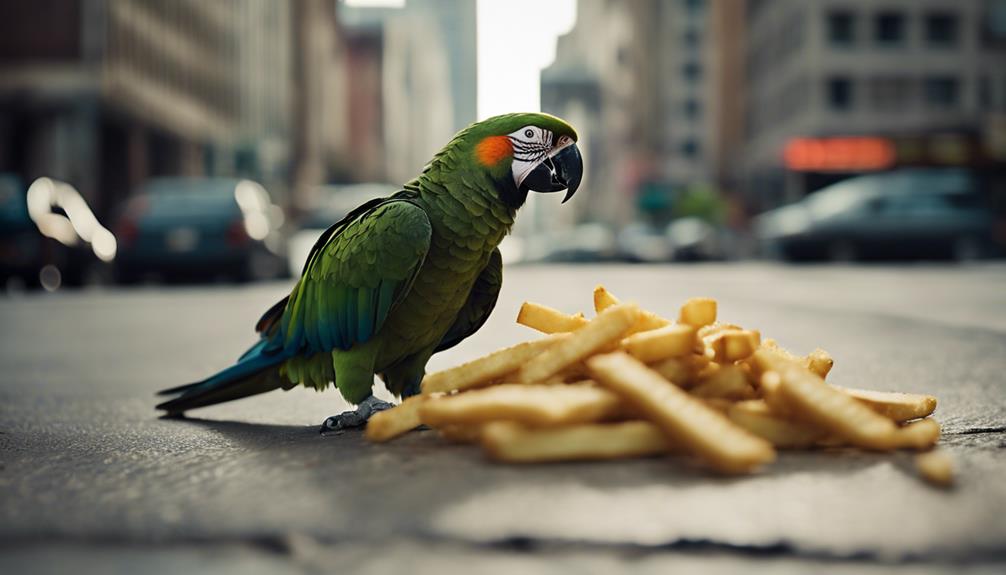
In adapting to urban environments, parrots have been observed modifying their diets to accommodate the availability of food sources in human-altered landscapes. These intelligent birds exhibit remarkable behavior changes to thrive in cities, where they face unique challenges. City scavenging becomes a common practice for urban parrots as they exploit new food sources such as discarded human food, fruits from ornamental trees, and seeds from urban gardens. The shift towards scavenging reflects their adaptability to changing environments, demonstrating a flexible foraging behavior.
However, this diet modification comes with nutritional challenges. Urban environments may lack the diversity of nutrients found in their natural habitats, leading to potential deficiencies. Parrots may need to supplement their diets with artificial sources or adapt their digestive systems to process different types of food efficiently. Understanding how parrots navigate these dietary changes is essential for conservation efforts in urban areas and provides valuable insights into the adaptability of these charismatic birds.
Vocal Communication in Noisy Settings
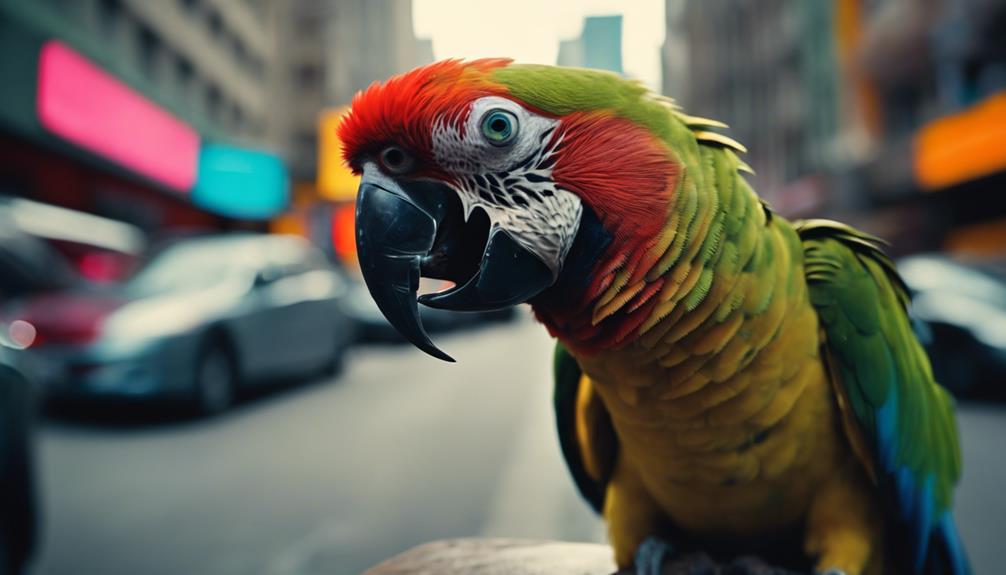
Urban parrots face significant challenges in maintaining effective vocal communication in noisy settings. Urban environments are often inundated with various sources of human-made sounds. To adapt, these birds have been observed modifying their vocalizations in pitch, frequency, and amplitude to ensure their messages are transmitted efficiently.
Understanding these adaptations can provide valuable insights into how wildlife copes with anthropogenic disturbances in their environments.
Noise Impact on Communication
The vocal communication of urban parrots faces significant challenges when subjected to high levels of ambient noise in their surroundings. In noisy settings, signal clarity becomes crucial for effective communication among parrots. Communication challenges arise due to the interference caused by urban sounds, impacting the transmission and reception of vocal signals. Parrots need to adjust their vocalizations to ensure they are heard and understood by their counterparts amidst the cacophony of the city. This adaptation allows them to maintain social bonds, establish territories, and convey warnings efficiently. By modulating their calls and using different frequencies, urban parrots can overcome the hurdles posed by noise pollution in their environment.
| Signal Clarity | Communication Challenges | Urban Noise Impact |
|---|---|---|
| Essential for effective communication | Arises due to interference from city sounds | Challenges transmission and reception of vocal signals |
Vocal Adaptations in Cities
Adapting to the challenges of high ambient noise levels in urban environments, parrots exhibit vocal modifications to enhance signal clarity in their communication.
Urban acoustics pose significant obstacles to effective vocal communication for parrots due to the presence of constant background noise from traffic, construction, and human activities.
To counteract this, parrots have developed the ability of vocal mimicry, allowing them to adjust the frequency, amplitude, and duration of their calls to stand out amidst the urban cacophony.
By mimicking sounds they encounter in their environment, such as alarms or sirens, parrots can create distinct vocalizations that cut through the noise, ensuring their messages are heard clearly by conspecifics.
These adaptations showcase the remarkable flexibility and ingenuity of parrots in adapting to urban challenges.
Social Adaptation to Human Presence

In close proximity to human habitats, parrots have been observed adjusting their social behaviors to accommodate human presence. These adaptations are crucial for their survival and successful cohabitation in urban environments.
- Increased Tolerance: Parrots exhibit higher tolerance levels towards human interactions, leading to reduced stress levels within the flock.
- Altered Vocalizations: Changes in vocalizations allow parrots to communicate effectively amidst urban noise pollution, ensuring flock dynamics remain intact.
- Altered Feeding Behavior: Parrots modify their feeding habits to include human-provided food sources, enhancing their adaptability to urban settings.
- Shifts in Roosting Sites: Urban roosting sites are chosen strategically to balance safety from predators and proximity to human resources.
- Adaptation in Nesting Behavior: Nesting behaviors are adjusted to urban structures like buildings and parks, showcasing their ability to utilize human-made environments.
These social adaptations highlight the remarkable flexibility and intelligence of parrots in integrating with human communities while maintaining their natural behaviors.
Utilizing Green Spaces in Cities

Parrots in urban environments demonstrate a remarkable utilization of green spaces within cities, showcasing their adaptive behavior towards incorporating natural elements into their habitat. These vibrant birds have been observed flocking to community gardens, not only to forage for food but also to socialize and engage in communal roosting activities. Community gardens provide a valuable resource for parrots, offering a diverse array of plants and insects for them to feed on, as well as safe spaces for nesting and resting.
Additionally, rooftop gardens have become popular among urban parrot populations. These elevated green spaces offer a sanctuary for foraging, enabling the parrots to access a variety of fruits, seeds, and flowers. The elevated vantage point also serves as a strategic lookout for potential predators, enhancing the safety of the parrots while they search for food.
Coping With Pollution and Toxins
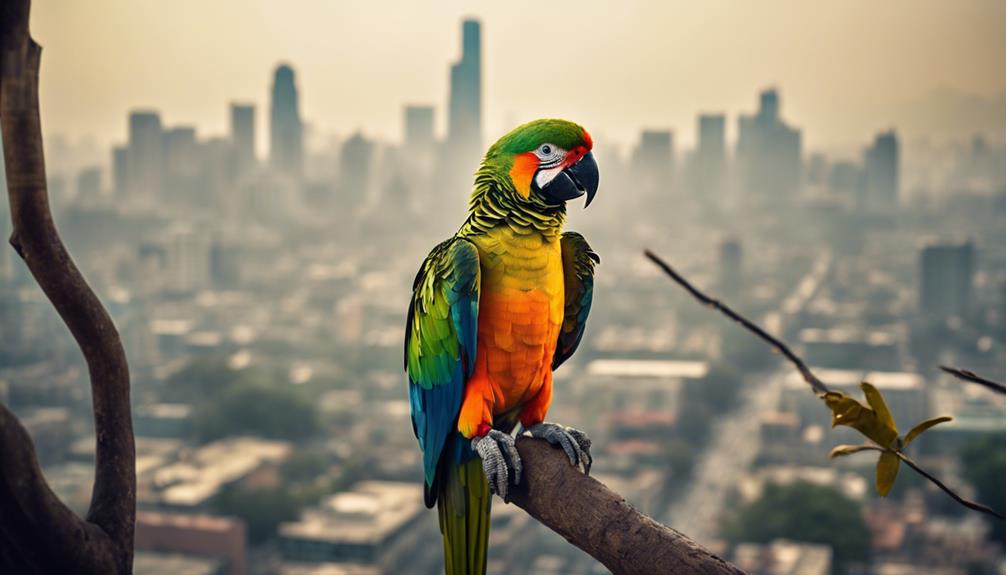
Urban parrots residing in polluted environments have developed unique physiological mechanisms to cope with the presence of toxins in their surroundings. These adaptations enable them to thrive amidst the challenges posed by pollution and toxins.
- Air Quality and Respiratory Health: Urban parrots have developed specialized respiratory systems that allow them to filter out pollutants and maintain optimal oxygen intake.
- Food Contamination and Digestive System Adaptations: Their digestive systems have evolved to handle potential contaminants in their food sources, aiding in efficient nutrient absorption while minimizing the impact of toxins.
- Enhanced Detoxification Processes: These parrots have enhanced detoxification pathways in their livers and kidneys to eliminate harmful substances more effectively.
- Behavioral Changes: Urban parrots exhibit altered foraging behaviors to minimize exposure to polluted areas and contaminated food sources.
- Adaptation to Noise Pollution: In addition to physical adaptations, these parrots have also adjusted their vocalization patterns to communicate effectively in noisy urban environments while reducing stress levels.
Strategies for Avoiding Urban Predators
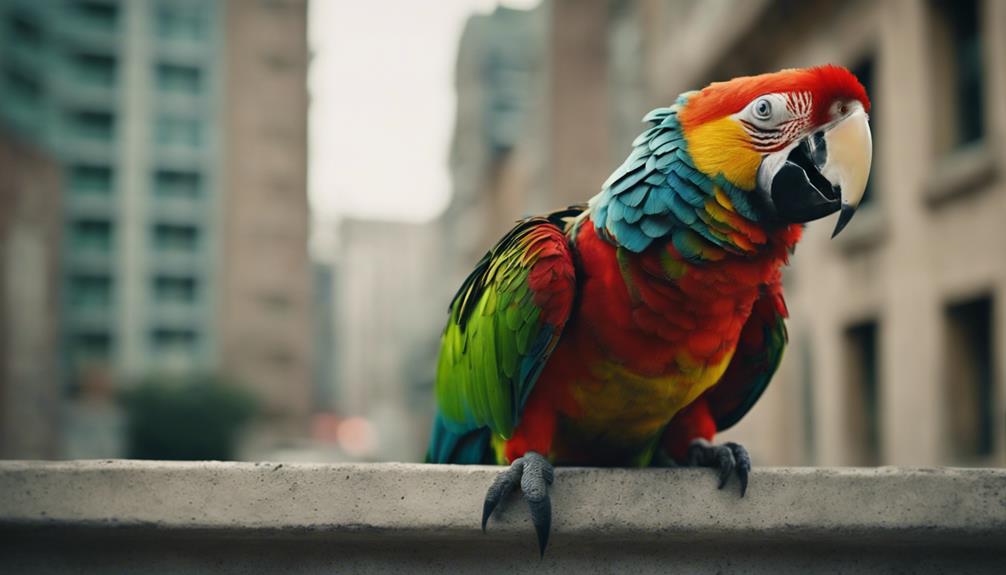
Urban parrots have developed intricate predator avoidance techniques to navigate the dangers of city environments. These include utilizing urban camouflage tactics to blend into their surroundings and employing defensive flock behaviors to ward off potential threats.
Understanding these strategies sheds light on the remarkable adaptability of these birds in the face of urban challenges.
Predator Avoidance Techniques
Employing a variety of stealth techniques, urban parrots demonstrate remarkable adaptability in evading potential predators within their city habitats. These intelligent birds have developed specific predator avoidance techniques that help them thrive in urban environments.
Some of these strategies include:
- Utilizing visual mimicry techniques: Parrots blend in with their surroundings by mimicking the colors and patterns of urban structures.
- Employing behavioral camouflage strategies: They modify their behavior to avoid detection, such as staying still or flying silently.
- Utilizing high vantage points: Parrots perch in elevated areas to keep an eye out for predators from a safe distance.
- Utilizing group behavior: They often move in flocks, increasing their chances of spotting predators early.
- Utilizing rapid flight maneuvers: Parrots are agile flyers, capable of quick evasive actions to escape potential threats.
Urban Camouflage Tactics
Utilizing their natural instincts and adaptive behaviors, urban parrots employ a range of sophisticated camouflage tactics to evade predators in their city habitats. Urban blending is a key strategy used by these intelligent birds to blend in with the urban environment, making it harder for predators to spot them. City roosting also plays a significant role in their camouflage tactics, as parrots often choose roosting spots that provide them with ample coverage and protection from potential threats. By strategically selecting roosting locations that offer natural barriers or mimicry of urban structures, parrots increase their chances of avoiding detection by predators. This ability to camouflage themselves in the urban landscape showcases the remarkable adaptability of urban parrots to survive and thrive in their man-made surroundings.
| Camouflage Tactics | Description |
|---|---|
| Urban Blending | Blending in with the urban environment to avoid predators |
| City Roosting | Selecting roosting spots that provide coverage and protection from threats |
Defensive Flock Behaviors
Drawing on their collective intelligence and social dynamics, urban parrots exhibit intricate defensive flock behaviors aimed at evading urban predators in their city environments.
These behaviors include:
- Roosting strategies: Parrots carefully choose secure locations for resting and sleeping to minimize the risk of predation.
- Alarm calls: Parrots use specific calls to alert others in the flock of potential dangers, allowing for coordinated responses.
- Flock cohesion: Parrots stay in close proximity to one another while foraging or flying, increasing their overall awareness and protection.
- Diverse flock formations: Parrots may adopt various formations while flying to confuse predators and enhance their chances of escaping.
- Vigilant sentinel behavior: Some individuals within the flock take on the role of sentinels, scanning the surroundings for threats and alerting the group when needed.
Frequently Asked Questions
Parrots navigate urban environments by utilizing their keen sense of observation. They communicate with each other to locate suitable nesting sites in man-made structures. By adapting their food sources and breeding habits, they thrive amidst human development.
What Specific Modifications Do Parrots Make to Their Diet in Order to Forage for Food in Urban Settings?
In urban environments, parrots adapt their feeding behavior to survive. They make dietary changes by foraging for food from various sources like fruits, seeds, and even human leftovers. These modifications help them thrive in urban settings.
How Do Parrots Adapt Their Vocal Communication in Noisy Urban Environments to Effectively Communicate With Each Other?
Parrots in urban settings face unique challenges due to noise pollution. To overcome this, they adapt their vocal communication by employing vocal mimicry and adjusting their frequencies to effectively communicate with each other amidst the urban noise.
What Are Some Specific Ways in Which Parrots Socially Adapt to the Presence of Humans in Urban Areas?
In the bustling urban landscape, parrots cleverly navigate human interactions by adjusting their group dynamics and behavioral patterns. They showcase remarkable survival strategies, adapting socially to coexist harmoniously with humans while safeguarding their own well-being.
How Do Parrots Utilize Green Spaces in Cities for Activities Such as Foraging and Socializing With Other Parrots?
Parrots in urban environments utilize green spaces for foraging and socializing. City flocks often congregate in these areas, exhibiting adaptive behaviors like urban roosting. These activities showcase the remarkable ability of parrots to thrive in changing landscapes.




